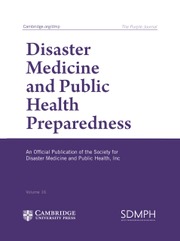No CrossRef data available.
Article contents
Evaluating the Difference in Emergency Nurses’ Disaster Response Self-Reported Confidence and Assessed Knowledge Scores: A Randomized Controlled Trial
Published online by Cambridge University Press: 23 June 2025
Abstract
The objective is to determine if a practical face-to-face emergency disaster incident response training program delivered in the clinical setting will improve self-reported confidence and assessed knowledge of emergency department (ED) nurses to respond to disasters.
A single site prospective pre-test and post-test randomized controlled trial was adopted for this study. The intervention was a practical face-to-face training program, while the control group completed the required annual mandatory hospital online training.
There was a large difference in post-test median self-reported confidence between groups. There was also a large difference in the proportion of subjects who reached satisfactory levels of self-reported confidence post-test. Regarding assessed knowledge, there was a moderate difference in post-test median knowledge between groups. There was also a moderate difference in the proportion who reached satisfactory levels of knowledge post-test.
This study has shown that ED nurses who undertake a practical face-to-face disaster preparedness education program in the clinical setting, are better prepared to respond to emergency disaster incidents. Organizations should consider the use of a practical structured face-to-face emergency disaster incident response education program to complement and enhance any online emergency and disaster training.
Keywords
Information
- Type
- Original Research
- Information
- Copyright
- © The Author(s), 2025. Published by Cambridge University Press on behalf of Society for Disaster Medicine and Public Health, Inc

